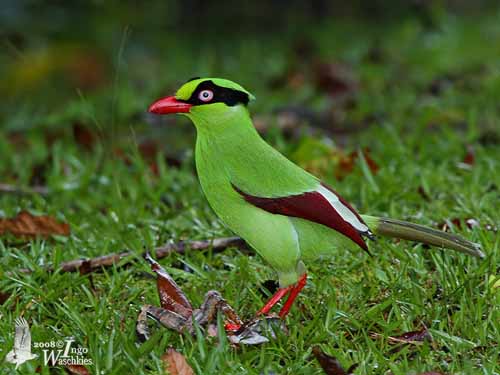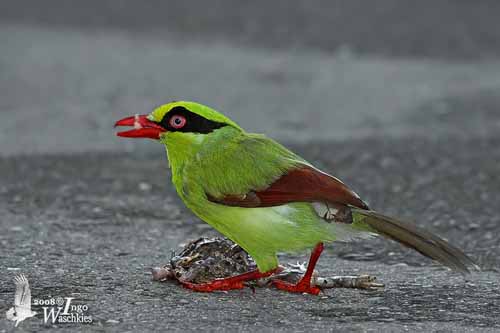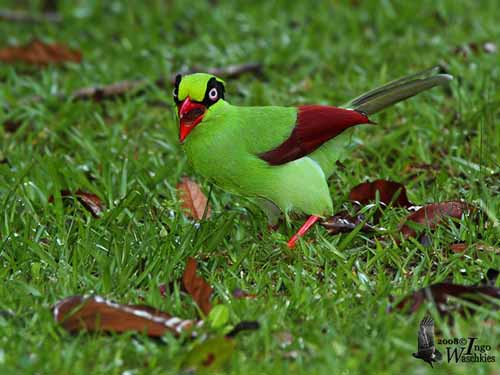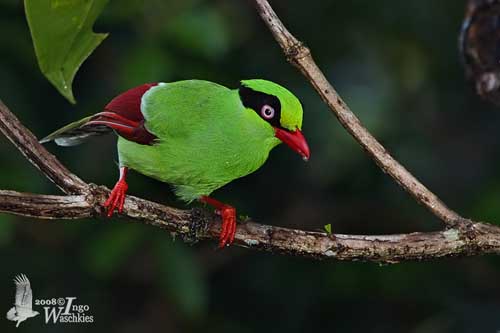
PROTECTION / THREATS / STATUS:
The Short-tailed Green Magpie is not currently threatened. The race “jefferyi” can be seen in higher-elevation forests in Mt Kinabalu National Park where the species is protected.
In Java, the race “thalassina” is confined in submontane rainforest areas between 1000 and 1200 metres of elevation.
Both races have restricted range, but they are evaluated as Least Concern by Birdlife International.
Fr: Pirolle à queue courte
All: Buschelster
Esp: Urraca Colicorta
Ital: Gazza verde codabreve
Nd: Kortstaartkitta
Sd: Kortstjärtad skata
Photographer:
Ingo Waschkies
My bird pictures on Pbase
Texte de Nicole Bouglouan
Sources:
HANDBOOK OF THE BIRDS OF THE WORLD Vol 14 by Josep del Hoyo-Andrew Elliot-David Christie - Lynx Edicions –
ISBN: 9788496553507
L’ENCYCLOPEDIE MONDIALE DES OISEAUX - Dr Christopher M. Perrins - BORDAS - ISBN: 2040185607
BirdLife International (BirdLife International)
Wikipedia, the free encyclopaedia
Short-tailed Green Magpie
Cissa thalassina
Passeriforme Order – Corvidae Family
BIOMETRICS:
Length: 31-33 cm
Weight: 125 g
DESCRIPTION:
The Short-tailed Green Magpie is endemic to the montane forests of Borneo and Java.
This is a striking bright-coloured magpie.
These pictures show the race Crissa thalassina jefferyi from Borneo.
Both adults are similar.
The adult is light green overall, yellower on the crown and the underparts.
On the upperwing, the primary coverts and the flight feathers are reddish-chestnut. Tertials are pale green with black-edged tips.
The uppertail is bronze-green with light green uppertail-coverts. The tail is graduated and relatively short. The outer tail feathers show whitish tips.
The top of the head is light yellowish-green. We can see a conspicuous black mask extending from the bill base, across the eyes and the head sides to the nape. The green feathers of the hind crown form a short crest above the black band.
The strong bill, legs and feet are bright red. The eyes are dark brown with crimson eye-ring in nominate race.

The race Crissa thalassina jefferyi here displayed is darker than nominate and almost uniform apple-green with yellow wash on the forehead.
The eyes are bluish-white to whitish with pale blue orbital ring and narrow red eye-ring. The black mask is broader above the eye than in nominate race, and tapers almost in a point, whereas it is flatter in C.t. thalassina.
The juvenile is duller with brown bill and legs.
The immature resembles adults with duller plumage, showing pale greyish wash on mantle and scapulars. The flight feathers are rather dull chestnut than reddish-chestnut. The undertail-coverts are greyish-white.

VOICE: SOUNDS BY XENO-CANTO
The Short-tailed Green Magpie of nominate race has poor repertoire, whereas the voice of “jefferyi” is sweet and musical. The bird utters series of 4-5 clear notes “swe-swi-swee-swi-swe-sweet” repeated after short pause with some variations. It also utters a penetrating “sweeeii” and a repeated “swe-swe-gurg” or “swe-gurg”.

HABITAT:
The birds of Java occur in narrow belt of submontane rainforest in foothills, between 1000 and 1200 metres of elevation.
In Borneo, the Short-tailed Green Magpie is found in true montane forest, between 900 and 2400 metres.
RANGE:
The Short-tailed Green Magpie C.t. thalassina is found in W Java.
The race C.t. jefferyi occurs in N Borneo, from Mt Kinabalu S to Mt Murud, the Usan Apan Plateau and Mt Dulit.
BEHAVIOUR:
The Short-tailed Green Magpie feeds mainly on snails, various insects and their larvae, small frogs, lizards, snakes, birds’ eggs and nestlings, some fruits and carrion.
This species is often seen alone, in pairs or in family groups according to the season. They forage in the dense undergrowth, on the ground, through shrub layers, clambering between the hanging vegetation, and sometimes reaching the upper canopy.
It often feeds near the limit of the tree-line. They cross open areas from thicket to thicket, but it prefers the cover of vegetation.

The breeding behaviour is unknown. The species is probably monogamous as numerous Corvidae and solitary nester. They defend the territory and the nest-site.
It is sedentary in its range.
FLIGHT:
The Short-tailed Green Magpie only makes short flight from forested area to other one.
REPRODUCTION:
In Borneo, the egg laying occurs in early February, and family groups are reported in April.
The Short-tailed Green Magpie builds a cup-shaped nest with thin twigs, with a base made of stronger sticks, dry leaves of bamboo and grass. The interior is lined with blackish rootlets.
The eggs are whitish.
Currently, there is not available information about the nesting behaviour.
DIET:
The Short-tailed Green Magpie feeds on snails, insects and their larvae such as beetles, crickets and mantises, small frogs, lizards, snakes, birds’ eggs and nestlings, some fruits and carrion.
They forage from the ground to the upper canopy with babblers (Timaliidae) and drongos (Dicruridae).
